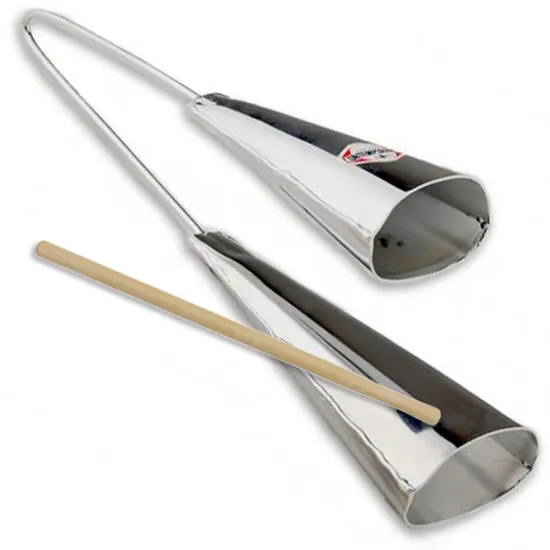Agogô
Melodic Percussions
Africa
Between 1001 and 1900 AD
Video
The agogô is a traditional percussion instrument characterized by its unique structure and sound. It consists of two or more metal bells or tubes of varying sizes, typically mounted together on a stand. This instrument is integral to various musical styles, especially in Afro-Brazilian and Latin music.
Playing Techniques
To play the agogô:
- Hold the instrument with one hand, gripping the handle.
- Use the other hand to hold the beater.
- Stroke the upward-facing sides of the bells near their rims to produce sound.
The agogô is known for its rhythmic versatility and remains an important instrument in both traditional and contemporary musical contexts.
History of the Agogô
The agogô is a musical instrument with deep roots in West African culture, particularly among the Yoruba and Edo peoples. Its history is intertwined with the transatlantic slave trade, which facilitated its introduction to Brazil, where it became a vital component of Afro-Brazilian music.
It produces bright, metallic tones that can enhance the rhythmic texture of music. Each bell generates a different pitch, allowing for simple melodies and intricate rhythmic patterns. The instrument’s sound is described as clear and resonant, making it a valuable addition to percussion ensembles.
Origins in Africa
The agogô has its origins in traditional African music, where similar instruments like the gankogui and Ewe agogô were used in ceremonies and festivals for centuries. These instruments were often crafted from natural materials and played a role in religious rituals, marking significant events and facilitating communication within communities. In Africa, particularly among the Yoruba, the agogô was associated with the god Ogun, the deity of iron and war. It was considered sacred, and musicians often underwent purification rites before playing it.
Introduction to Brazil
The agogô was brought to Brazil by enslaved Africans during the 16th to 19th centuries. Once in Brazil, it adapted to local musical styles and became integral to various cultural expressions, including samba and capoeira. Over time, the agogô evolved in design and function. It transitioned from a sacred object into a popular instrument used in festive celebrations such as carnivals. In Brazil, it is commonly referred to as “agogô de metal” to distinguish it from wooden versions.
Construction and Design
Material: Originally made from wrought iron, modern agogôs can be crafted from various metals, enhancing their sound quality.
Structure: Typically, the agogô features two bells connected by a U-shaped metal piece. The bells vary in size, allowing for different pitches when struck. The smaller bell is usually positioned above the larger one
Playing Technique: Musicians use a wooden or metal stick to strike the bells, creating either a cowbell-like sound or a clicking sound by squeezing the bells together.
Historical Context
The agogô was introduced to Brazil by enslaved Africans during the transatlantic slave trade. It was utilized in religious rituals and celebrations within Afro-Brazilian communities. Over time, it has adapted to various musical styles, including samba and capoeira, becoming a staple in Brazilian carnival music.
Cultural Significance
The agogô is prominently featured in religious ceremonies and cultural practices such as Candomblé and Macumba. It serves not only as a musical instrument but also as a means of communication within communities
The agogô is considered one of the oldest instruments used in samba music. It contributes to the rhythmic foundation of samba baterias (percussion ensembles) and is essential during carnival celebrations.
Rhythmic Patterns
The agogô is known for its ability to produce various rhythmic patterns essential to Afro-Brazilian music. Some common patterns include:
- Basic Pattern: A straightforward 4/4 rhythm often used in traditional dances.
- Embellished Patterns: More complex variations that incorporate additional strokes to enrich the rhythm
Modern Usage
In contemporary music, the agogô has found its way into various genres beyond traditional Afro-Brazilian music. It has been featured in popular songs across rock and funk genres, showcasing its versatility as an instrument.
Notable examples include:
- Barry Manilow’s “Copacabana”
- Ohio Players’ “Love Rollercoaster”
- Songs by bands like Soulfly and Doves incorporate agogô sounds into their arrangements
The agogô continues to be celebrated for its rich cultural heritage and its dynamic role in both traditional and modern musical contexts.
FAQ
What is the Agogô used for?
The agogô is used as a percussion instrument in Afro-Brazilian music, particularly in samba and capoeira. It produces a bright, metallic tone and is played by striking its bells with a stick. The agogô sets rhythmic patterns, adds melodic accents, and helps drive the energy of the performance.
How to make an Agogô?
To make an agogô, take two hollow metal cones or bells of different sizes. Weld or attach them to a metal rod or frame, ensuring they are securely connected. The bells can be struck with a wooden or metal stick to produce sound. For a traditional approach, you can also carve the agogô from wood or bamboo, shaping it to create resonant tones.
How does Agogô work?
The agogô works by producing sound when its metal or wooden bells are struck with a stick. Each bell is tuned to a different pitch, allowing players to create rhythmic patterns and melodic accents. The vibration from the strike resonates within the hollow bell, amplifying its bright, metallic tone. It is often used to maintain rhythm in traditional and modern music.
 Links
Links
References
Other Instrument
Categories


















